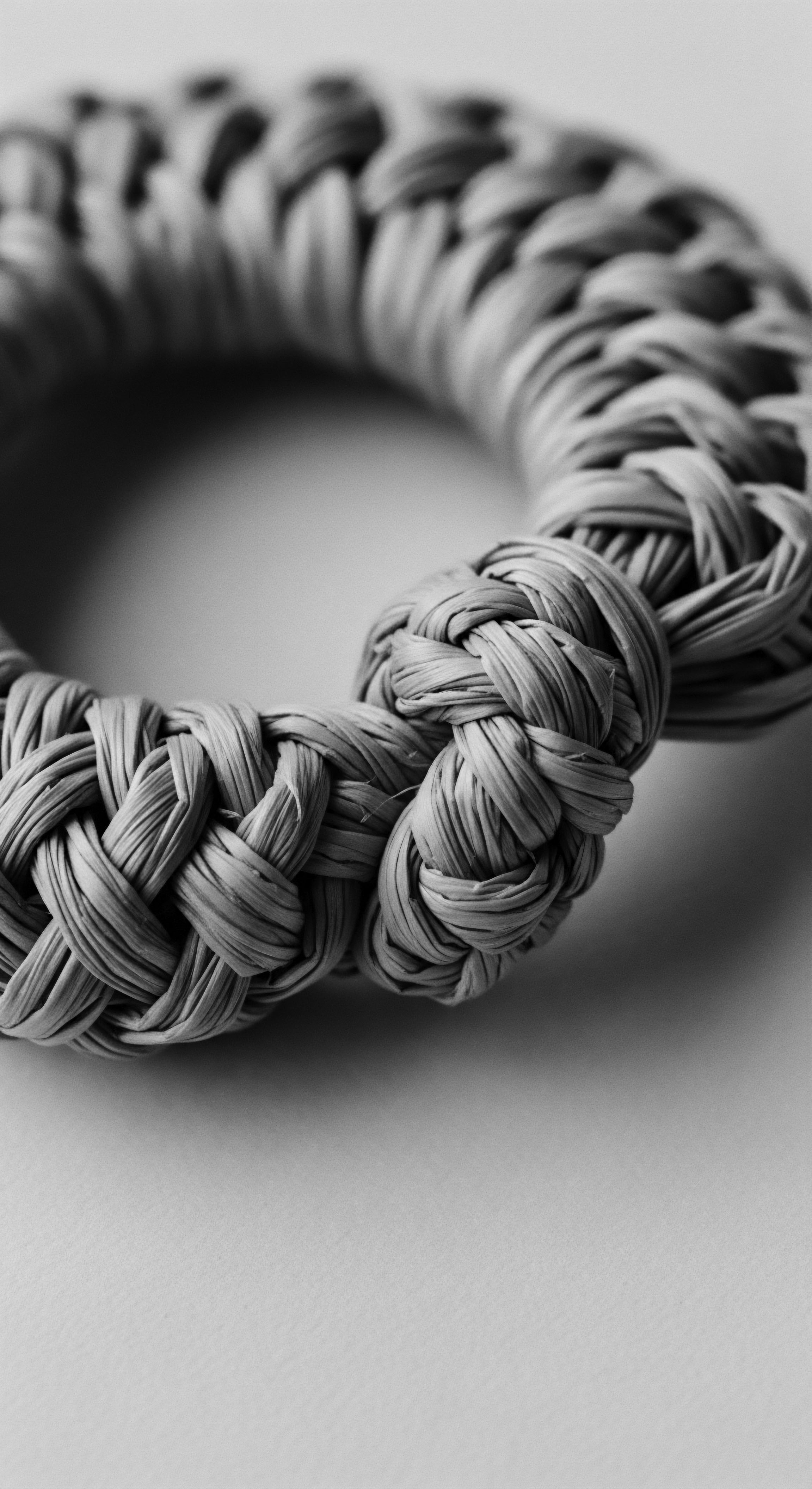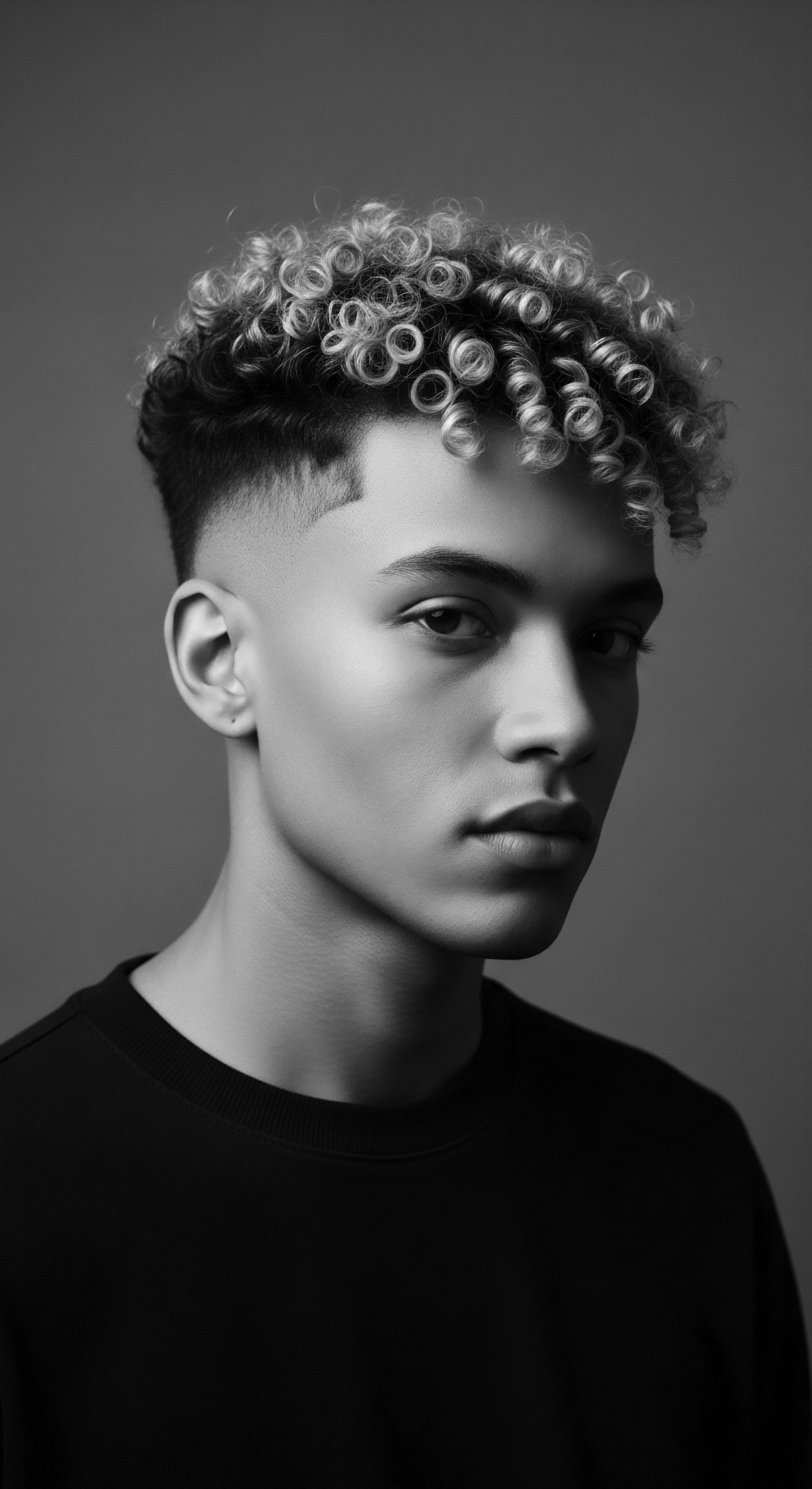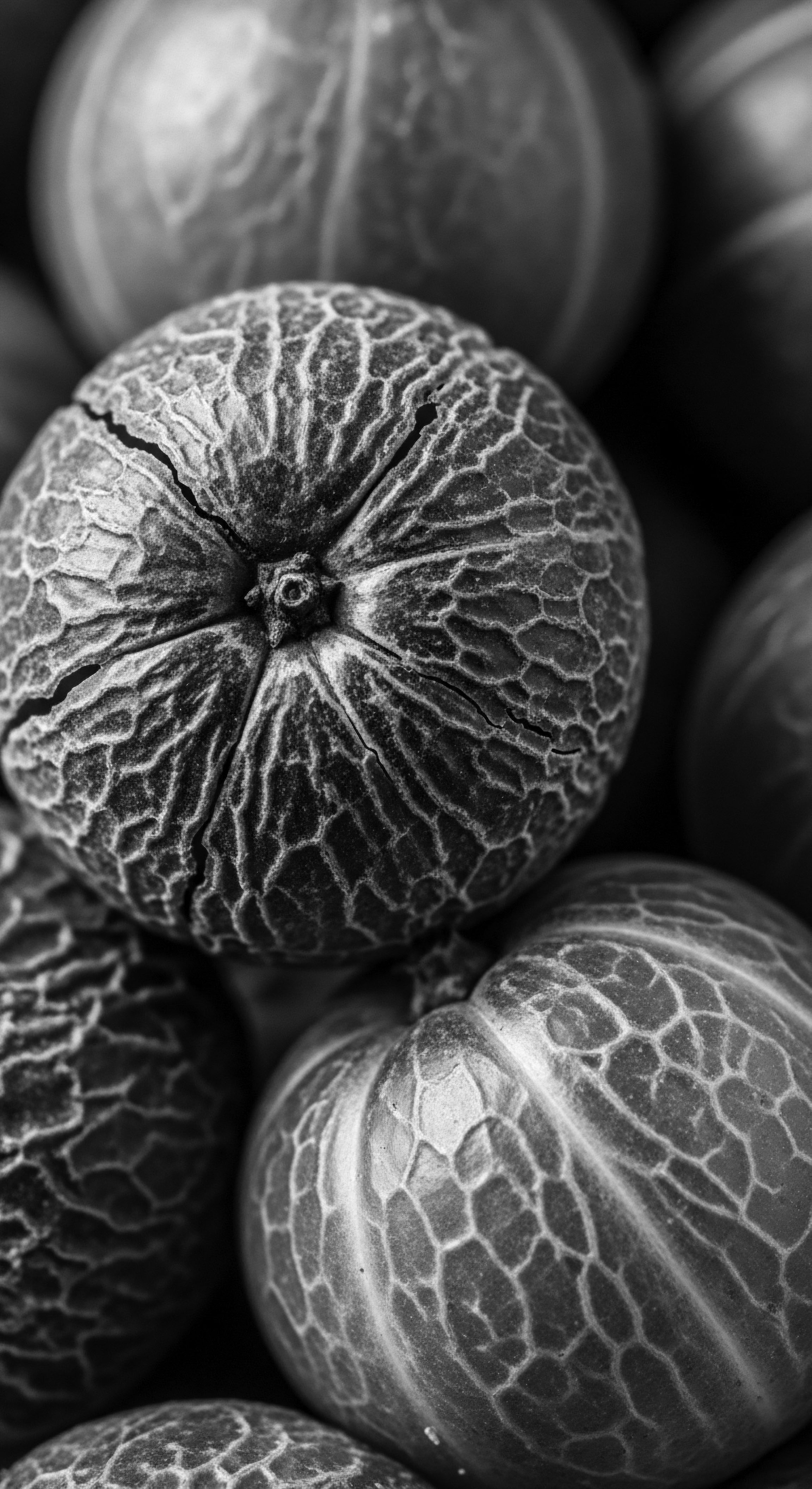
Roots
To truly comprehend the profound journey of textured hair, one must begin at its very wellspring, not merely in its biological intricacies, but in the echoes of ancestral wisdom that shaped its meaning for millennia. Our hair, particularly in its coily and kinky forms, is a living archive, a scroll unfurling the stories of resilience, identity, and deep connection to the earth and spirit. It is an extraordinary biological marvel, yet its true significance transcends molecular structures or growth cycles. It holds within its very curl pattern a lineage, a whispers of epochs long past, inviting us to listen closely to the traditions that bound it to ancestral practices.
Centuries before scientific instruments parsed protein bonds, ancient communities held a discerning understanding of hair’s diverse forms. Across African societies, this understanding was often intuitive, based on observation and the lived experience of cultivating and caring for these crowns. Hair was never seen as uniform; its varied densities, porosities, and curl patterns were recognized, not through clinical classification, but through the rich tapestry of terms and methods developed for their unique care.
These distinctions were interwoven with social structures and spiritual beliefs, forming a lexicon that spoke of belonging, status, and life’s passages. A Mandingo’s tight coils differed visually from an Ashanti’s looser curl, and each bore a distinctive path for adornment and expression.

The Biological Canvas An Ancestral View
The physical nature of textured hair, characterized by its elliptical follicle shape and the consequent helical curl pattern, renders it distinct. This shape, unlike the round follicle that produces straight hair, causes the hair strand to twist and turn as it grows, creating the distinctive spirals we recognize. From a modern scientific standpoint, this structure, while beautiful, makes textured hair more prone to dryness and breakage due to the open cuticles at the bends of each curl and the longer path oils must travel from the scalp. However, ancestral practices, born of necessity and deep observation, predated this scientific explanation, intuitively developing methods that countered these very challenges.
Ancestral communities discerned textured hair’s variations not through clinical labels, but through a language of lived care and symbolic meanings.
Consider the earliest approaches to hair care, often rooted in elemental biology and environmental adaptation. Communities residing in arid regions, for instance, learned early to shield hair from the sun’s intensity and dust, favoring protective styles and nourishing balms. The very elements that could challenge hair’s health spurred ingenious solutions.
The understanding of what nourished and protected these hair types was gained through generations of trial, observation, and shared wisdom. Ingredients derived directly from the land—butters, oils, clays, and herbs—became the foundational components of hair care, their efficacy proven through enduring health and vibrant appearance.

Early Lexicon Of Hair Heritage
The language used to describe textured hair in ancient traditions was not merely descriptive; it was often imbued with social and spiritual weight. Terms for hair might refer to one’s age, marital status, or even lineage. For example, in many West African cultures, specific hair formations could communicate whether a woman was a maiden, newly married, or a respected elder.
Hair was a living bulletin board of personal history and communal standing. The very act of naming a hairstyle or hair type connected it to a larger cultural narrative, a heritage that transcended individual preference.
- Ozondato ❉ Worn by young Himba girls in Namibia, these two braids symbolize youth and innocence, a clear marker of life stage.
- Otjize ❉ A paste of red ochre, butterfat, and aromatic resin used by the Himba tribe, not only styling but also protecting hair from the elements and symbolizing connection to land and ancestors.
- Irun Didi ❉ A Yoruba term from Nigeria, specifically for braided hair, demonstrating a long-standing traditional naming for structured styles like cornrows.

Ritual
The journey from elemental biology to an intricate understanding of textured hair finds its most vibrant expression within the realm of ritual. Here, the act of hair care transcends mere grooming, transforming into a sacred communal practice, a living art, and a profound declaration of identity. Traditional hair rituals were not solitary affairs; they unfolded as collective moments, strengthening bonds, transferring knowledge, and reaffirming cultural continuity. The hands that braided, twisted, or coiled hair were guided by generations of inherited wisdom, each movement a whisper of ancestral care.

Ancestral Styling Techniques And Tools
Long before modern salons, ancient African civilizations developed sophisticated techniques for styling and preserving textured hair, often with tools crafted from the natural world. Braiding, for instance, emerged as early as 3500 BCE, with rock paintings in the Sahara desert showing women adorned with cornrows. These styles were deeply functional, protecting hair from harsh environments and promoting healthy growth, yet they also served as intricate communication systems. Different patterns could identify tribal affiliation, age, marital status, wealth, or social rank.
Consider the ingenuity of early tools. Archaeological discoveries from Kush and Kemet (ancient Sudan and Egypt) reveal wooden, bone, and ivory combs, often buried with their owners, testament to hair’s sacred standing and the reverence for its tools. These were not simple implements; they bore hand-carved symbols reflecting tribal identity, fertility, and even spiritual protection. The act of using such tools became an extension of the ritual itself, a tangible link to the past.
The diversity of traditional styles speaks to a profound artistry. From the tightly coiled Bantu knots, a style tracing its heritage to the Bantu-speaking communities of Southern and Central Africa, to the elaborate crown-like Shuku braids of the Yoruba people, which once signified high status. Each style held its own story, its own connection to the community’s history and values. The Fulani people of West Africa, for example, are renowned for their slender braids adorned with cowrie shells and beads, which signal fertility and social standing.
| Tool Afro Comb (wood, bone, ivory) |
| Traditional Context Ancient Kush and Kemet (Sudan, Egypt) |
| Cultural Significance Spiritual gateway, social communication, buried with owners due to sacred status. |
| Tool Hair Beads/Cowrie Shells |
| Traditional Context Fulani (West Africa), Igbo (Nigeria), Himba (Namibia) |
| Cultural Significance Symbol of fertility, wealth, social status, good luck, tribal affiliation. |
| Tool Red Ochre Paste (Otjize) |
| Traditional Context Himba Tribe (Namibia) |
| Cultural Significance Protection from sun/insects, connection to land and ancestors. |
| Tool These tools represent a heritage of creativity and deep understanding of hair's role beyond mere aesthetics. |

Hair As A Language A Deeper Meaning
The visual vocabulary of hair in ancestral practices communicated volumes. A person’s hairstyle could convey their geographic origins, their current emotional state, or their readiness for marriage. Among the Mursi people of Ethiopia, specific braiding forms were integrated into funeral rituals, creating a tangible connection to ancestors. The artistry involved in these creations often required hours, even days, of meticulous work, fostering deep social bonds as families and friends gathered, sharing stories and wisdom, while hands carefully sculpted hair.
This communal aspect of hair care reinforced familial ties and community cohesion. Learning to braid was often a rite of passage for young girls, symbolizing their transition to womanhood and the passing down of cultural knowledge from elders. These sessions were not just about creating a hairstyle; they were forums for intergenerational exchange, where history was orally preserved, and a sense of shared heritage was reinforced with every section, twist, and plait. This intimate process underscores how hair rituals served as anchors for cultural identity.
Hair rituals were not merely acts of grooming, but communal ceremonies reinforcing cultural ties and passing down ancestral knowledge.

The Spiritual Connection Of Hair
Across many African traditions, hair holds a powerful spiritual significance, often considered the highest point of the body and a conduit to the divine. It was believed to be a channel for energy, a means of ancestral communication, or a source of spiritual protection. Specific styles or the inclusion of certain adornments were thought to invite blessings, ward off negativity, or honor deities.
For instance, the Akan people in Ghana revered matted locks, called mpesempese, as a symbol of higher power, reserved for priests. This demonstrates how deeply spiritual beliefs were woven into the very fabric of hair practices, positioning hair as a sacred element of self.

Relay
The current of ancestral wisdom flows through generations, adapting and transforming, yet carrying the undeniable essence of its origins. This relay of knowledge, particularly concerning textured hair, demonstrates profound resilience in the face of immense historical pressure. The journey from ancient communal rituals to contemporary self-expression reveals a continuum of heritage, where traditional practices often find validation in modern scientific understanding, and where challenges became catalysts for new forms of cultural affirmation.

The Resilience Of Hair Traditions Through Adversity
The transatlantic slave trade presented a brutal assault on the identity and established practices of enslaved Africans. As millions were forcibly removed from their homelands, one of the first acts of dehumanization was often the shaving of their heads. This act sought to strip them of their cultural identity, social status, and spiritual connections, forcing a severance from a heritage deeply tied to hair. Yet, even in such devastating circumstances, the ingenuity and determination of a people found ways to preserve and adapt.
Hair, in a remarkable act of defiance, transformed into a covert medium of communication and resistance. A poignant example, meticulously documented in historical accounts, involves the use of cornrows. Enslaved African women in Colombia, under the leadership of Benkos Biohó—a king captured from Africa who later escaped slavery and established the village of San Basilio de Palenque—utilized specific cornrow patterns to convey secret messages and even maps for escape. One style, known as ‘departe,’ featured thick, tightly braided rows tied into buns atop the head, signifying the intent to flee.
Curved braids would represent the winding roads or escape routes, literally carrying the path to freedom upon one’s head. Seeds, even gold fragments, were sometimes hidden within these intricate patterns, providing sustenance or resources for survival once escape was achieved. This practice, a subtle yet powerful act of rebellion, allowed enslaved people to maintain a connection to their heritage and agency under brutal conditions (Andel, 2020).
Hair, under duress, transformed into a tool of survival, with cornrows secretly mapping paths to freedom and carrying seeds for a new life.
The legacy of such resistance echoes into the 20th century with movements like “Black Is Beautiful” and the Black Power movement, where the Afro became a powerful political statement. Figures like Angela Davis, with her prominent Afro, stood as symbols of self-love, a rejection of Eurocentric beauty standards, and a powerful assertion of Black identity and pride. This period marked a significant shift, reclaiming natural hair as a symbol of liberation and cultural affirmation, demonstrating a continuous thread of resistance through hair.

How Does Science Validate Ancestral Hair Care?
While traditional practices emerged from observation and necessity, modern hair science offers validation for many ancestral methods. The deep understanding of ingredients, passed down through oral tradition, now finds scientific backing. Take, for instance, shea butter, a staple in many African communities for centuries. Its rich composition of fatty acids and vitamins provides intense moisture, sealing the hair cuticle and reducing dryness, a common concern for textured hair.
Castor oil, another historically used ingredient, is recognized for its emollient properties and ability to strengthen strands. These natural emollients, used to anoint the scalp and hair, align with current scientific understanding of lipid-based moisturizers and their role in maintaining hair health.
Protective styling, such as braids, twists, and locs, long employed in ancestral cultures, also aligns with modern hair care principles. These styles minimize daily manipulation, reduce exposure to environmental stressors, and help retain moisture, thereby decreasing breakage and promoting length retention. The scientific community now recognizes these benefits, echoing the practical wisdom of ancient practitioners who instinctively understood how to shield and preserve textured hair.

The Evolution Of Care A Continuous Lineage?
The journey of textured hair care has also involved adaptation and innovation within the diaspora. Figures like Dr. Willie Morrow stand as monuments to this adaptive spirit. Morrow, a self-taught chemist and barber, invented the Afro pick and developed products specifically for black hair, including an early form of the Jheri Curl.
His work, recognized by the Department of Defense in 1969 for teaching military barbers how to cut black hair globally, exemplifies how traditional knowledge and unmet needs spurred scientific inquiry and product development. He authored books like “400 Years Without a Comb” (Morrow, 1973), tracing the historical arc of black hair care, bridging ancestral practices with contemporary solutions.
This lineage extends to the present day, where a growing movement encourages a return to natural hair care rooted in ancestral wisdom, blending traditional ingredients with modern scientific understanding for holistic wellness. The reclamation of ancestral practices, from oiling rituals to protective styles, highlights a deep desire to reconnect with a heritage of resilience and beauty, acknowledging that the strands on our heads carry a story far older and deeper than any fleeting trend.
- Shea Butter ❉ Utilized for centuries, its fatty acid content provides moisture, reducing dryness in textured hair.
- Castor Oil ❉ A traditional emollient, recognized for strengthening strands and enhancing hair health.
- Aloe Vera ❉ Used for scalp health and conditioning in ancient Latin American and African practices, now valued for its soothing properties.

Reflection
In tracing the traditions that have connected textured hair to ancestral practices, we find ourselves contemplating more than historical facts or biological structures. We witness a vibrant, unbroken lineage, a continuous exchange between the past and the present, where every coil and curl holds a story. From the meticulous braiding of ancient African societies, reflecting intricate social hierarchies and spiritual beliefs, to the silent, subversive language of cornrows during enslavement, hair has consistently served as a canvas of identity, resistance, and unwavering heritage.
The wisdom passed down through generations—the intuitive understanding of natural ingredients, the communal rituals of care, the deep spiritual reverence—endures. This collective memory, preserved in textures and practices, extends beyond mere aesthetics. It speaks to a profound cultural anchoring, a celebration of self, and a powerful assertion of belonging. Textured hair, in its myriad forms, remains a living archive, breathing with the Soul of a Strand, inviting us to acknowledge the enduring legacy of those who came before us and to honor the vibrant traditions that continue to shape our connection to our heritage.

References
- Andel, T. (2020). How Enslaved Africans Braided Rice Seeds Into Their Hair & Changed the World. Shari Rose.
- Byrd, A. D. & Tharps, L. (2001). Hair Story ❉ Untangling the Roots of Black Hair in America. St. Martin’s Press.
- Dabiri, E. (2020). Twisted ❉ The Tangled History of Black Hair Culture. Harper Perennial.
- Johnson, T. J. & Bankhead, A. (2014). Black Women and Identity ❉ What’s Hair Got to Do With It? University of Michigan.
- Morrow, W. L. (1973). 400 Years Without a Comb. Morrow’s Unlimited, Inc.
- Rooks, N. M. (1996). Hair Raising ❉ Beauty, Culture, and African American Women. Rutgers University Press.
- Sieber, R. & Herreman, M. (2000). Hair in African Art and Culture. Museum for African Art.
